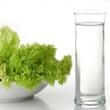Background
- Detoxification is a broad term that encompasses many different ways of cleansing the body's internal systems and organs. Major methods include chelation therapy (EDTA therapy), colonic irrigation, nutritional supplementation, several varieties of herbal medicine, dietary therapy, fasting, juicing, probiotics, hydrotherapy, sauna and exercise.
- Four main types of toxins are addressed through detoxification: heavy metals, chemical toxins, microbial compounds, and byproducts from protein metabolism. Advocates believe detoxification cleanses the body, clears the skin, enhances the senses, helps weight loss, improves fertility, improves flexibility, increases vitamin and mineral absorption, purifies, reduces blood fat levels, reduces symptoms of toxicity, rejuvenates, rests organs, and slows aging.
- Organs that perform detoxification functions for the body include the skin, liver, intestines and kidneys. Many methods of detoxification focus on strengthening or supporting the natural processes of these organs.
- For many methods of detoxification there is little or no evidence from clinical trials to enable recommendations for or against their use. See individual monographs on this site for reviews of the available evidence.
References
Natural Standard developed the above evidence-based information based on a thorough systematic review of the available scientific articles. For comprehensive information about alternative and complementary therapies on the professional level, go to . Selected references are listed below.
- Barak AJ, Beckenhauer HC, Junnila M, et al. Dietary betaine promotes generation of hepatic S-adenosylmethionine and protects the liver from ethanol-induced fatty infiltration. Alcohol Clin Exp Res 1993;17(3):552-555.
View Abstract - Chauhan BL, Kulkarni RD. Alcohol hangover and Liv.52. Eur J Clin Pharmacol 1991;40(2):187-188.
View Abstract - Chauhan BL, Kulkarni RD. Effect of Liv.52, a herbal preparation, on absorption and metabolism of ethanol in humans. Eur J Clin Pharmacol 1991;40(2):189-191.
View Abstract - de Silva HA, Saparamadu PA, Thabrew MI, et al. Liv.52 in alcoholic liver disease: a prospective, controlled trial. J Ethnopharmacol 2003;84(1):47-50.
View Abstract - Flora SJ, Singh S, Tandon SK. Prevention of lead intoxication by vitamin-B complex. Z Gesamte Hyg 1984;30(7):409-411.
View Abstract - Flora SJS, Jain VK, Behari JR, et al. Protective role of trace metals in lead intoxication. Toxicol Lett 1982;13:51-56.
View Abstract - Huseini HF, Alavian SM, Heshmat R, et al. The efficacy of Liv-52 on liver cirrhotic patients: a randomized, double-blind, placebo-controlled first approach. Phytomedicine 2005;12(9):619-624.
View Abstract - Naidu AS, Bidlack WR. Clemens RA. Probiotic spectra of lactic acid bacteria (LAB). Crit Rev Food Sci Nutr 1999;39(1):13-126.
View Abstract - Nigam P, Dayal SG, Mukhija RD, et al. Hepato-protective role of indigenous drug Liv-52 in lepromatous leprosy. Hansenol Int 1982;7(1):36-44.
View Abstract - Pound MW, May DB. Proposed mechanisms and preventative options of Jarisch-Herxheimer reactions. J Clin Pharm Ther 2005;30(3):291-295.
View Abstract - Ramalingam V, Sundaravalli N, Raju VB. Liv. 52 studies in acute hepatitis. Indian Pediatr 1971;8(12):839-842.
View Abstract - Sama SK, Krishnamurthy L, Ramachandran K, et al. Efficacy of an indigenous compound preparation (Liv-52) in acute viral hepatitis-a double blind study. Indian J Med Res 1976;64(5):738-742.
View Abstract - Stiefelhagen, P. Functional disorders call for total therapy -- Kneipp's hydrotherapy instead of psychopharmaceuticals. MMW Fortschr Med 5-5-2005;147(18):4-8.
View Abstract - Wisniewska-Knypl JM, Sokal JA, Klimczak J, et al. Protective effect of methionine against vinyl chloride-mediated depression of non-protein sulphydryls and cytochrome p-450. Toxicol Lett 1981;8(3):147-152.
- Zeisel SH, Da Costa KA, Franklin PD, et al. Choline, an essential nutrient for humans. FASEB J 1991;5(7):2093-2098.
View Abstract







